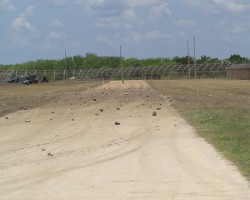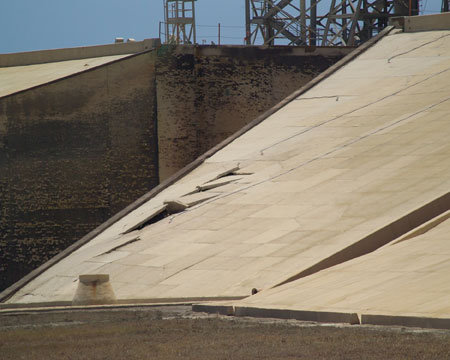The damage to Launchpad 39 A is apparently worse than first thought. According to a report from WESH TV in Orlando, not only were bricks blasted from launchpad walls during the launch of Discovery on May 31, 2008, but damage also extended hundreds of square feet under the pad. NASA Officials said engineers inspected the walls and found more areas ready to fail, making the pad dangerous to use. Repairs will begin as soon as possible, as there are only two launchpads for the shuttle. Complicating matters is that both pads, 39 A and 39 B must be available for the next space shuttle mission, a flight to the Hubble Space Telescope, and preliminary work has begun to switch 39 B from a shuttle launch pad to the site where the first Ares rockets will be tested next year for the new Constellation program.
STS-125’s mission to Hubble, scheduled for October 2008, will require a shuttle ready on each launchpad, as post-Columbia flight guidelines require a backup shuttle to serve as a recue ship for any mission not going to the International Space Station, where the crew could take refuge if any damage occurred that would prohibit the shuttle from landing.
So, just closing down the damaged Pad 39A is not an option, said shuttle program manager Leroy Cain. “We need both launch pads, so that’s not a negotiable term at this point.”
But switching to pad 39B as the primary launch pad would also present issues, as this site is currently being readied for launches for the Constellation program.
Last week’s launch tore huge gouges into the pad’s walls. Bricks were blasted and thrown on a roadway a quarter of a mile away, and into the waterway behind the pad. NASA is concerned about bricks being thrust up and damaging the space shuttle during future launches.

“We have lots of things that are susceptible to breaking away, or peeling away and hitting the launch vehicle,”said Leroy Cain. “Will there be impacts to the shuttle program, potentially the station, and no doubt the Constellation program? I’m sure there would be.”
Both launchpads were initially built to launch the Saturn rockets for the Apollo program, back in the 1960’s.
But as it stands now, Launchpad 39 A can’t be used again until NASA determines how and why the damage occurred, and how to prevent it from happening again.
Sources: WESH TV, NASA TV


Another example of the creeping meatballism that is the result of the idiots we vote into positions of power.
What’s wrong with you people. Highways, bridges, launch pads, etc are supposed to last forever.
Maintenance? What’s that. Remember, you voted for the assholes that have better things to do with your money.
june 11th, 7:58am. redzenman is already royally pissed. s’gonna be a tough day for him or her.
interesting article, Nancy. thanks.
I know you say there can’t be a permanent switch to platform B, but wouldn’t it make sense to do that, and then make the modifications to platform A while that’s being repaired anyway?
As for the backup shuttle for the Hubble mission – isn’t there something about there actually being an extra launch platform at another airforce base? It’s just never been used.
Sili – they were building a backup at Vandenburg in California. But according to Wikipedia, it wasn’t finished when the Challenger disaster happened, and was never completed.
Besides, Vandenburg was intended for polar launches – I don’t think the eastern neighbours would be happy having 2 SRBs drop on their heads in an eastern launch…
Besides, Vandenburg is farther north than KSC, so I don’t know if the shuttle could make it from there to the Hubble or not.
Thank you, Mike.
The ‘problem’ forums like this is that it’s so much easier to just throw questions out there rather than research them oneself.
Pity. I really really hope Hubble will get serviced.
Just launch the damn thing anyway! Hubble needs its TLC!
Hey! Everyone slow down. The fix is simple! NASA needs to hire an ocean going ship builder capable of forming and submerge-arc welding two or three inch thick cor-ten steel plates into an overlay. If the overlay is proped up a couple inches, they then able flood the underside with plain water coolant. Oop! I forgot for a moment. We’re talking about NASA thinking in simple terms. Sorry guys. Didn’t mean to waste your time.
A bit of sentence correction to the above. Should read “they then are able to flood the underside'” Didn’t have the second coffee yet.
It would take a lot of time and fuel to change orbits after launching from Vandenberg; since you couldn’t launch anywhere close to 45-55 degrees (well, at least without a lot of politicians getting involved). I can’t see it being used any time soon.